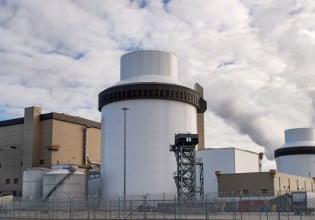Skeleton’s High-Energy Ultracapacitor Modules to Power Wrightbus Vehicles
Wrightbus and Skeleton Technologies join forces to encourage wide scale adoption of fuel-cell electric buses with Skeleton’s ultracapacitor technology.
A global leader in the development and manufacture of high energy and power density ultracapacitors, Skeleton Technologies has recently entered into a partnership to move the transportation industry toward a greener future. The company partnered with Wrightbus, a zero-emissions driven company based in Northern Ireland that delivers market-leading low-floor buses. The company gained great interest when they introduced the world to a first in hydrogen-powered transport, a zero-emission hydrogen double-decker bus in Aberdeen this month.
Wrightbus unveils its hydrogen-powered double-decker bus in Aberdeen. Image used courtesy of Wrightbus
In June 2019, Wrightbus was announced as a founding member of the H2Bus. The company joined forces with other key players in the hydrogen fuel cell electric value chain including Ballard Power Systems, Everfuel, Hexagon Composites, Ryse Hydrogen, and Nel Hydrogen.
The consortium focuses its attention on providing a minimum of 1,000 zero-emission Fuel Cell Electric Buses including related infrastructure to cities in Europe at commercially competitive rates. Interest in improving bus and bicycle infrastructure in the UK appears to be prominent. Earlier this year, the U.K. Government’s Department for Transport (DfT) announced a 5-year, £5 billion (US$6.4 billion) plan to drive this forward.
The Partnership
The partnership is hoped to promote the adoption of Wrightbus’ hydrogen vehicles. Skeleton will be providing its next-generation, high-energy ultracapacitor modules to power fuel cell buses in the UK. Skeleton’s ultracapacitor technology incorporates its own patented curved graphene which enables a higher power density, lower equivalent series resistance (ESR), and so longer lifetime durability in Skeleton’s ultracapacitors.
This is the first commercial release of Skeleton’s ultracapacitors. Combining this technology with fuel cells of electric vehicles can reduce stress on the fuel cell, improve the system range, and allow the system to run more efficiently.
In a recent news release Taavi Madiberk, CEO and co-founder of Skeleton Technologies provided his comments on the use of the company’s ultracapacitors within hydrogen fuel cell vehicles: “Hydrogen fuel cell vehicles are of high strategic importance to lower CO2 emissions and fight against climate change. Skeleton’s ultracapacitors are one of the key enablers of the hydrogen economy. Since fuel cells are not able to recuperate the braking energy and re-use it for acceleration, they need efficient energy storage devices to improve overall system efficiency and total cost of ownership. Combining ultracapacitors and fuel cells will speed up the market adoption of hydrogen fuel cell vehicles.”
Madiberk went on to express his enthusiasm for the opportunity to work with Wrighbus and believe that in the next 5 years, 1000 buses could be on the market.
Image used courtesy of Skeleton Technologies
In the same news release, Chairman of Wrightbus Jo Bamford gave his opinion on Skeleton’s curved graphene technology: “For hydrogen buses, Wrightbus is working with world-class leaders, such as Ballard Power for fuel cells and Skeleton Technologies for ultracapacitors. Ultracapacitors and fuel cells are the ideal combination for better performance and lower cost of ownership but until now ultracapacitors were lacking in energy density. Skeleton's Curved Graphene technology brings these needed improvements by doubling the energy density of ultracapacitors, and will therefore strongly contribute to the wide-scale adoption of fuel-cell electric buses.”
Both Skeleton and Wrightbus hope to make driving a greener future for the public across the world.






